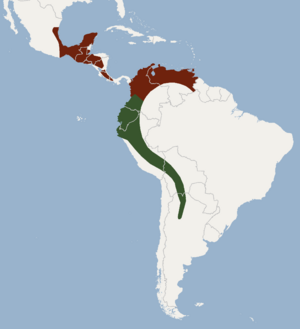Hairy-legged myotis facts for kids
Quick facts for kids Hairy-legged myotis |
|
|---|---|
 |
|
| Conservation status | |
| Scientific classification | |
| Genus: |
Myotis
|
| Species: |
keaysi
|
 |
|
| Synonyms | |
|
M. ruber keaysi |
|
The hairy-legged myotis (Myotis keaysi) is a type of mouse-eared bat. These bats live in many places, from southern Mexico through Central America. You can also find them in northern South America, reaching as far east as Trinidad. Further south, they live along the Andes mountains, all the way to northern Argentina.
Scientists first identified this bat in 1914. At first, they thought it was a smaller group (a subspecies) of other bats. But in 1973, they decided it was its own unique species. There are two main types, or subspecies, of the hairy-legged myotis:
- Myotis keaysi keaysi: Found in Argentina, Bolivia, Peru, Ecuador, and parts of south-western Colombia.
- Myotis keaysi pilosatibialis: Found in western Colombia, northern Venezuela, Trinidad, Central America, and southern and eastern Mexico.
Contents
About the Hairy-legged Myotis Bat
The hairy-legged myotis is a small bat. It measures only about 4 to 5 centimeters (about 2 inches) long. It weighs around 5 grams, which is about as much as two pennies!
What Does It Look Like?
This bat has long, sometimes woolly, fur. Its fur can be greyish or reddish-brown. Its name comes from the thick fur on its legs. It also has fur on the top part of its tail membrane, called the uropatagium. This is the skin that stretches between its legs. While other bats might have some fur there, the hairy-legged myotis has a lot more. The fur covers at least half of this membrane, reaching from its knee almost to its foot.
The hairy-legged myotis also has fur on the upper part of its main wing membrane, called the plagiopatagium. This is the part of the wing closest to its body. The fur can be quite thick and reaches as far as its elbows. The parts of its wings that don't have fur are dark brown or black.
Where Do Hairy-legged Myotis Live?
These bats live in many different types of forests. They can be found in dry scrubland or in wet tropical rainforests. Most hairy-legged myotis live from sea level up to about 2,400 meters (about 7,900 feet) high. However, some have been seen even higher, up to 3,350 meters (about 11,000 feet) in Peru.
Bat Roosts and Colonies
During the day, these bats like to rest in safe places. They often choose caves or hollow trees. Sometimes, they even roost under human-made structures like roofs or bridges.
Hairy-legged myotis often roost in small groups of two to eight bats. But in caves, you might find much larger groups. Some colonies can have over five hundred bats!
Life and Habits of the Hairy-legged Myotis
Like many bats, the hairy-legged myotis is nocturnal. This means it is active at night. They are also insectivorous, which means they eat insects. They start flying around sunset to hunt for food. They usually return to their roosts about an hour before the sun comes up.
These bats seem to travel long distances to find food. Scientists have caught the same bat in different places up to 1,450 meters (nearly a mile) apart! They make short, loud calls that help them find their way and catch insects. These calls are very high-pitched, around 59 to 63 kHz.
Reproduction and Bat Pups
Hairy-legged myotis bats can have babies throughout the year. However, in places like Central America, more births happen between May and June.
See also
 In Spanish: Myotis keaysi para niños
In Spanish: Myotis keaysi para niños


